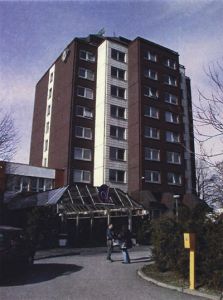| ||||||||||||||||||||||||||||||||||||||||||||||


Strakonice
 Strakonice
lies in a beautiful part of South Bohemia at the confluence of the rivers Volyhka
and the gold-bearing Otava. Over the centuries the history of the town has been
closely linked with the history of the castle, founded in the 2nd half of the
12th century by the noble family of Bavor. Bavor I. of Strakonice brought the
Knights of St. John (known as Malthusians) to the castle. The castle became
their property in the 15th century, and remained in their hands until 1926 when
it was sold. The history of the castle is demonstrated by the evolution of its
building styles. The Romanesque-Gothic St. Prokop Church and cloister were built
in the 13th century. The Rumpal tower on a pear-shaped ground plan was added
later. Once a prison, it serves today as an outlook point. Most of the murals
in the cloister and chapter hall have been dated to the 1st half of the 14th
century. In 1421 the castle became the abbot's residence. The first abbot built
the Jelenka tower and the southern palace. Nowadays art exhibitions and classical
music concerts are held there. The eastern palace was finished in 1715.
Strakonice
lies in a beautiful part of South Bohemia at the confluence of the rivers Volyhka
and the gold-bearing Otava. Over the centuries the history of the town has been
closely linked with the history of the castle, founded in the 2nd half of the
12th century by the noble family of Bavor. Bavor I. of Strakonice brought the
Knights of St. John (known as Malthusians) to the castle. The castle became
their property in the 15th century, and remained in their hands until 1926 when
it was sold. The history of the castle is demonstrated by the evolution of its
building styles. The Romanesque-Gothic St. Prokop Church and cloister were built
in the 13th century. The Rumpal tower on a pear-shaped ground plan was added
later. Once a prison, it serves today as an outlook point. Most of the murals
in the cloister and chapter hall have been dated to the 1st half of the 14th
century. In 1421 the castle became the abbot's residence. The first abbot built
the Jelenka tower and the southern palace. Nowadays art exhibitions and classical
music concerts are held there. The eastern palace was finished in 1715.
Today the castle houses an exhibition of the Museum of the Central Otava Basin including e.g. an archaeological exhibition, Gothic statues and an exposition on the history of bagpipe playing.
Until the 19-th century Strakonice was a small, agriculturally-orientated, country town. The citizens, mostly farmers, peasants and craftsmen made their livelihood from the production of red stockings amongst other things. In 1828 a Jewish businessman Volf Furth obtained permission from the Guild of Stocking Makers to sell fezes. The first fez factory was opened in 1828 and today the Fezko company is known all over the world (especially in Turkey, of course). The Czech munitions factory was founded in 1919 and has above all spread the town's fame through its manufacture of small arms and motorcycles.
Although the town itself is not very spectacular, there are some interesting monuments there; the Baroque plaque column in the centre of Palacky Square, St. Margaret's Church, originally Renaissance and re-styled in Baroque fashion in the 18th century, and the Gothic cemetery Church of St. Wenceslas (Vaclav) from the late-13th century, which was also re-styled in the Baroque manner in the 18th century. On Velke Square the Baroque portal of old butcher's shops and the graffiti designed by Mikolas Ales on the old town hall can be seen as well as the Savings Bank (Spofitelna) building and the renovated Papal (Papezovy) houses.
|
|
|
|
